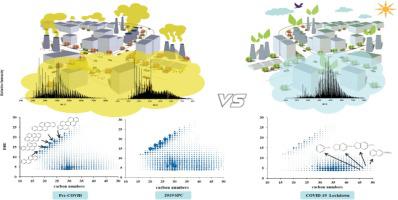Environment International ( IF 11.8 ) Pub Date : 2022-07-16 , DOI: 10.1016/j.envint.2022.107421 Chi Xu 1 , Lirong Gao 2 , Yibing Lyu 3 , Lin Qiao 4 , Di Huang 4 , Yang Liu 4 , Da Li 5 , Minghui Zheng 6

|
Aromatic compounds, including many polycyclic aromatic hydrocarbons (PAHs), are suspected carcinogens and may originate from different sources. To investigate the impact of anthropogenic emission reductions on unknown aromatic compounds in particulate matter, we collected samples during the pre-COVID period in 2020, the COVID-19 lockdown period in 2020, and the same period as the lockdown in 2019. Besides the 16 PAHs, other aromatic compounds were analyzed by Fourier transform ion cyclotron resonance mass spectrometry and comprehensive two-dimensional gas chromatography-time-of-flight mass spectrometry. Four main compound classes were identified: CH, CHO, CHNO, and CHOS. Hierarchical cluster analysis showed the aromatic compounds varied during the different periods. Compared with before the pandemic, the relative abundances of aromatic compounds with low degrees of unsaturation and long alkyl chains (e.g., alkylbenzenes) increased. These compounds probably mainly arose from fossil fuel combustion and petrochemical industry emissions. The CHO compounds, which were dominated by those with high degrees of oxidation, might originate from secondary organic aerosols. Aromatic aldehydes (e.g., cyclamen aldehyde) and benzoates (e.g., 2-ethylhexyl benzoate) probably with high toxicity deserve more attention. During lockdown, nitro derivatives of condensed PAHs were the main CHNO compounds, and the numbers of homologs decreased perhaps because of significant reductions in NOx and PAHs. CHOS compounds with long carbon chains and low degrees of unsaturation were predominant and the numbers of homologs increased. Five compounds (e.g. 1,3-dimethyl pyrene) were predicted to possibly exhibit persistent and bio-accumulated by EPI Suite model, which need further research. The results provide insight on aromatic compounds and their source appointment in atmospheric particulate matter.
中文翻译:

COVID-2019期间颗粒物中芳香族化合物的分子特征、来源和环境风险:超高分辨率质谱和综合二维气相色谱的非目标筛选
芳香族化合物,包括许多多环芳烃 (PAHs),被怀疑是致癌物,可能来自不同的来源。为了研究人为减排对颗粒物中未知芳香族化合物的影响,我们在 2020 年 COVID 之前的时期、2020 年的 COVID-19 封锁期和 2019 年封锁期的同一时期收集了样本。除了 16采用傅里叶变换离子回旋共振质谱法和综合二维气相色谱-飞行时间质谱法对多环芳烃和其他芳香族化合物进行了分析。确定了四种主要的化合物类别:CH、CHO、CHNO 和 CHOS。层次聚类分析表明,芳香族化合物在不同时期有所不同。与疫情前相比,具有低不饱和度和长烷基链的芳族化合物(例如烷基苯)的相对丰度增加。这些化合物可能主要来自化石燃料燃烧和石化工业排放。以高氧化度为主的CHO化合物可能来源于二次有机气溶胶。可能具有高毒性的芳香醛(如仙客来醛)和苯甲酸盐(如苯甲酸2-乙基己酯)值得更多关注。在锁定期间,缩合多环芳烃的硝基衍生物是主要的 CHNO 化合物,同源物数量减少可能是因为 NO 显着减少 这些化合物可能主要来自化石燃料燃烧和石化工业排放。以高氧化度为主的CHO化合物可能来源于二次有机气溶胶。可能具有高毒性的芳香醛(如仙客来醛)和苯甲酸盐(如苯甲酸2-乙基己酯)值得更多关注。在锁定期间,缩合多环芳烃的硝基衍生物是主要的 CHNO 化合物,同源物数量减少可能是因为 NO 显着减少 这些化合物可能主要来自化石燃料燃烧和石化工业排放。以高氧化度为主的CHO化合物可能来源于二次有机气溶胶。可能具有高毒性的芳香醛(如仙客来醛)和苯甲酸盐(如苯甲酸2-乙基己酯)值得更多关注。在锁定期间,缩合多环芳烃的硝基衍生物是主要的 CHNO 化合物,同源物数量减少可能是因为 NO 显着减少x和多环芳烃。具有长碳链和低不饱和度的CHOS化合物占主导地位,同系物数量增加。EPI Suite 模型预测五种化合物(例如 1,3-二甲基芘)可能表现出持久性和生物累积性这些结果提供了对芳香族化合物及其在大气颗粒物中的来源指定的见解。


























 京公网安备 11010802027423号
京公网安备 11010802027423号